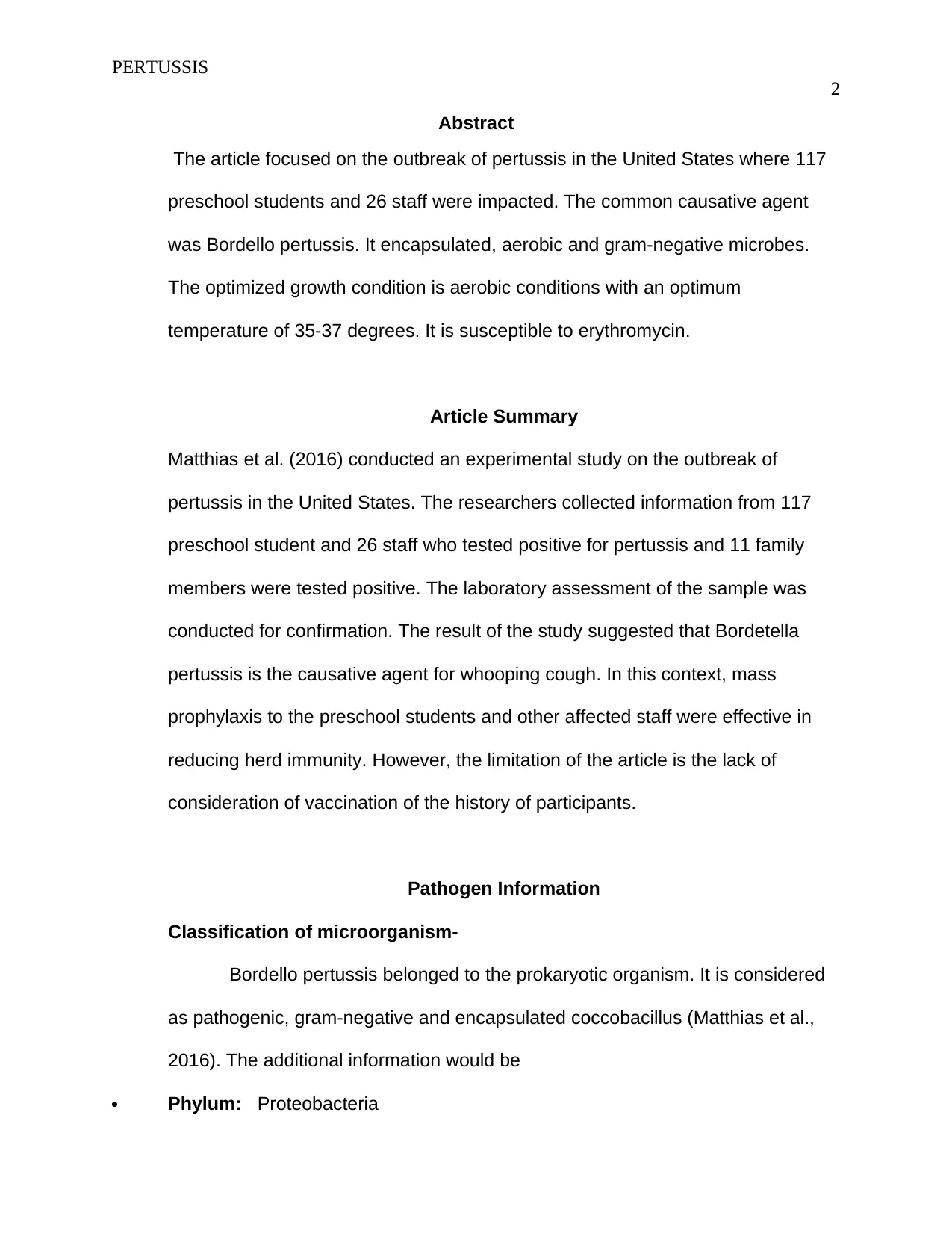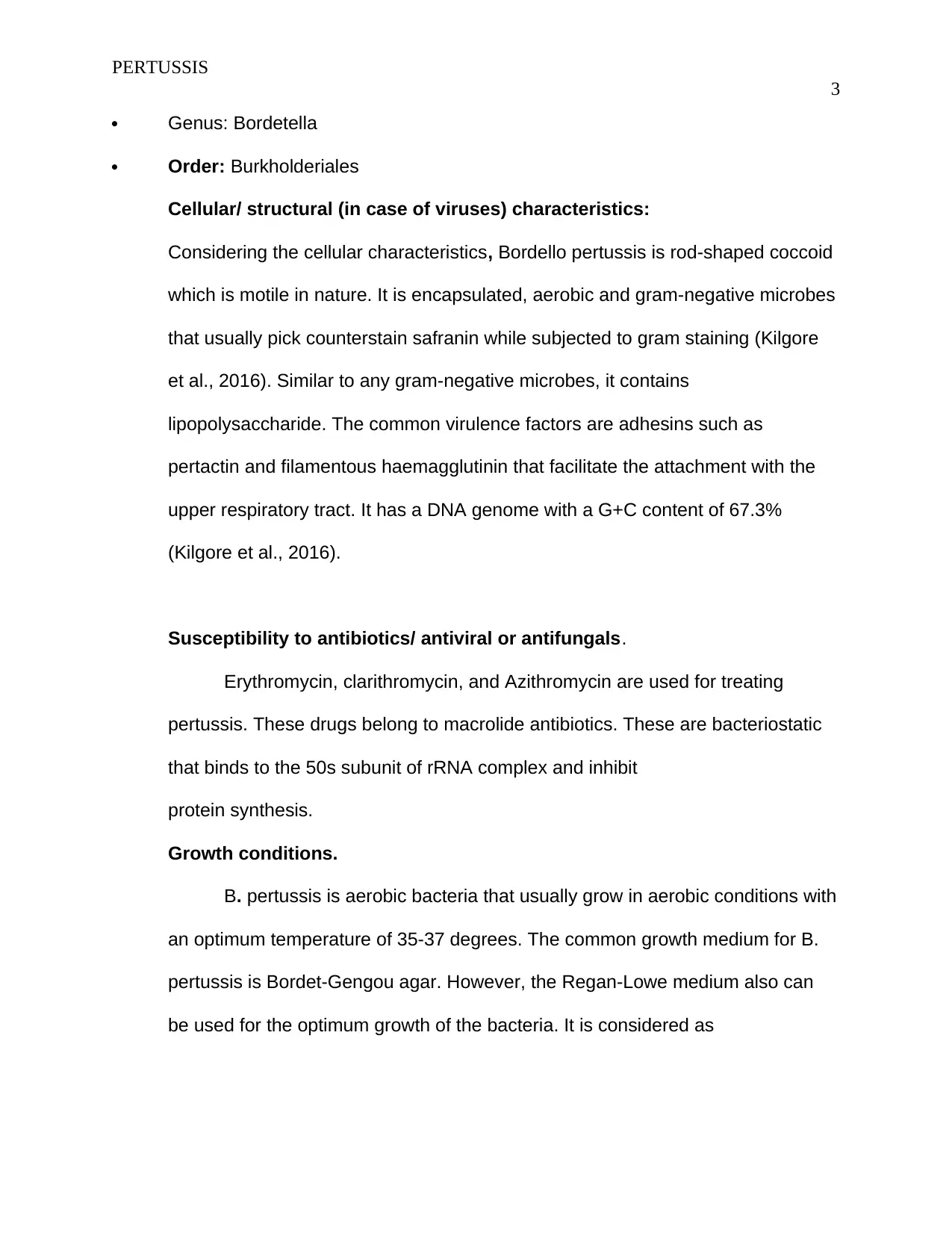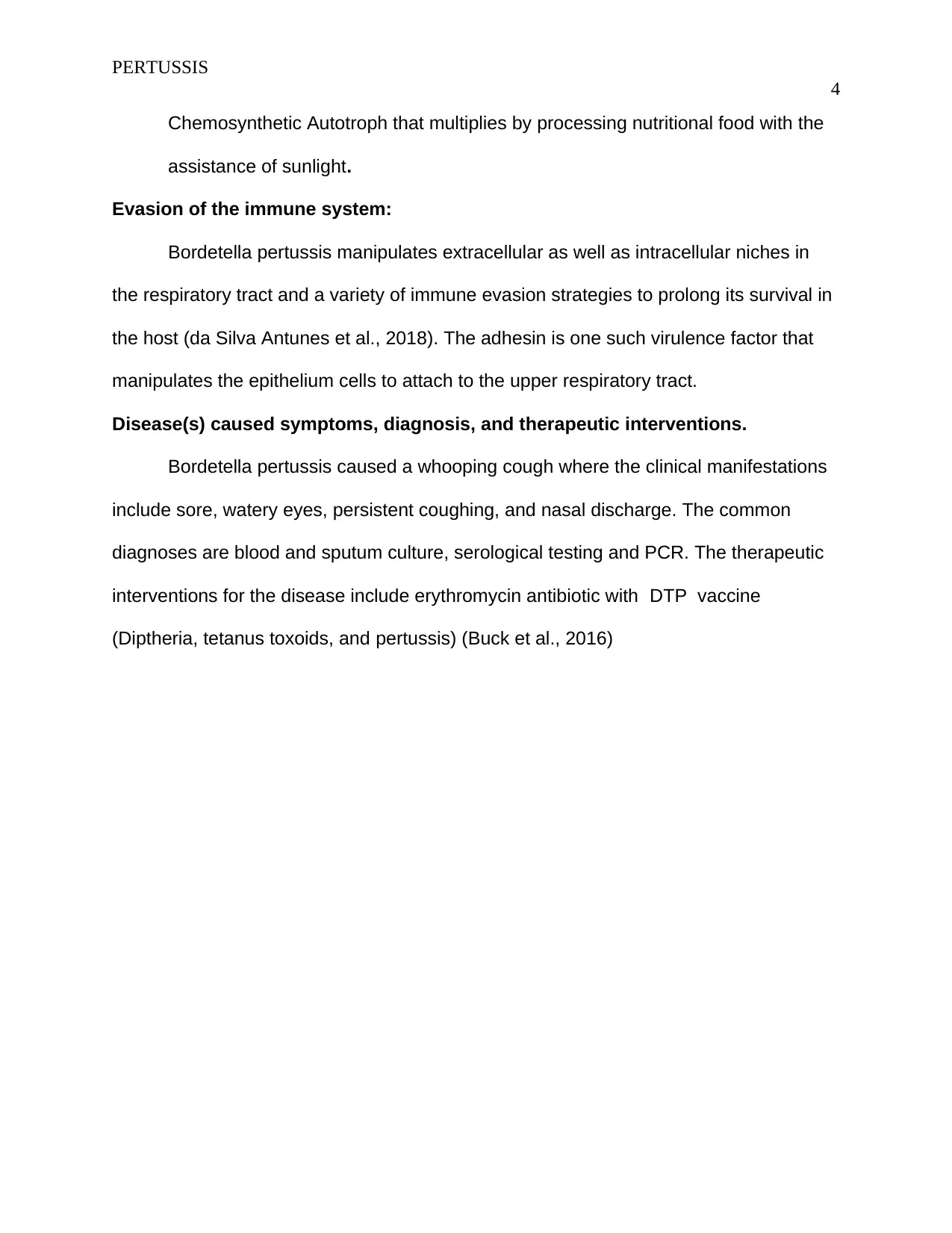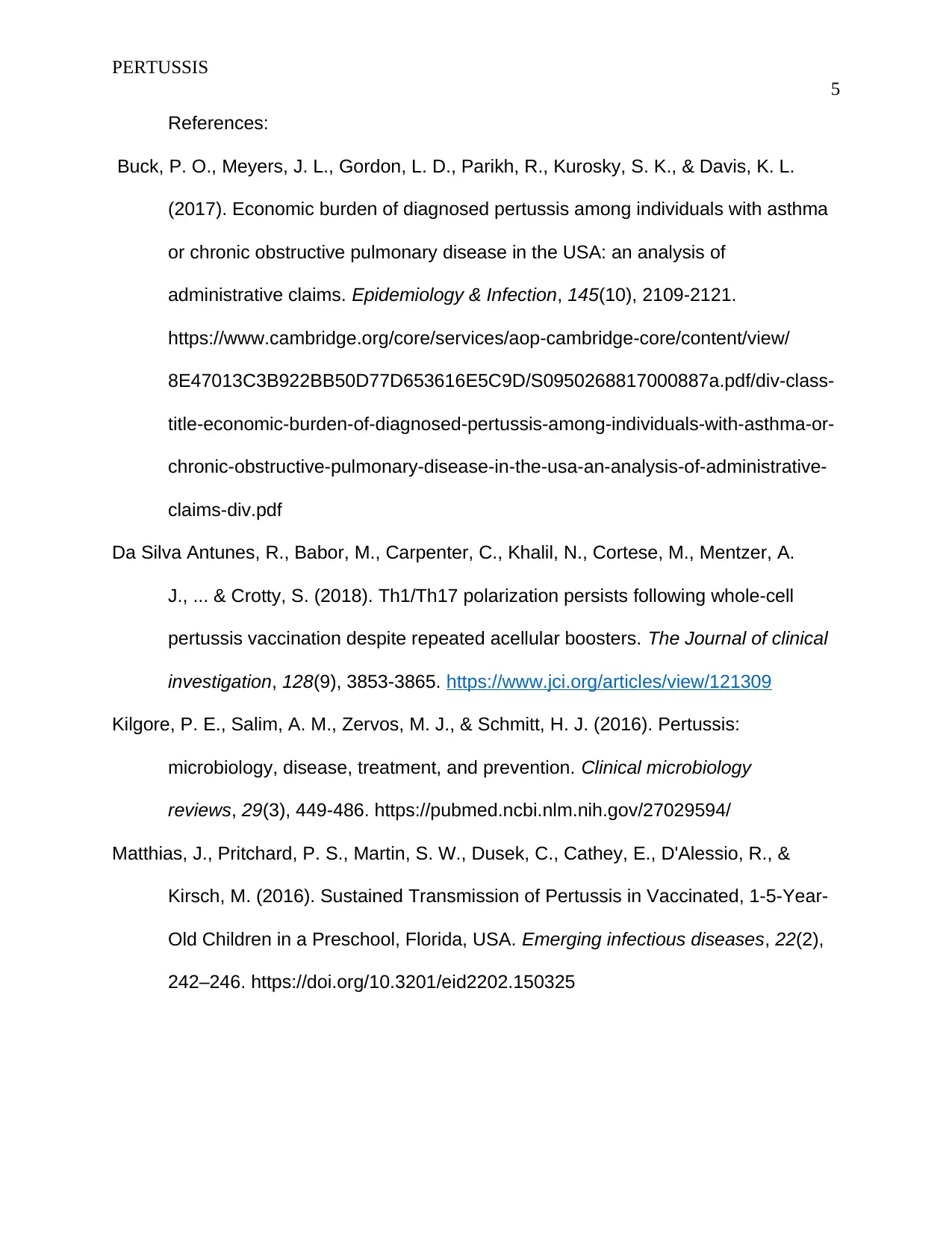Chamberlain University: Pertussis Report and Pathogen Analysis
VerifiedAdded on 2022/09/25
|5
|833
|22
Report
AI Summary
This report provides a detailed analysis of Pertussis, focusing on an outbreak in the United States involving preschool students and staff. The causative agent, Bordetella pertussis, is examined, including its classification, cellular characteristics, and virulence factors such as adhesins. The report discusses the bacterium's susceptibility to antibiotics like erythromycin and its growth conditions. It also covers immune evasion strategies, disease symptoms (whooping cough), diagnostic methods, and therapeutic interventions, including the DTP vaccine. The report references key research articles and provides a comprehensive overview of the disease, its causative agent, and treatment options.

PERTUSSIS
1
TITLE
NAME
CHAMBERLAIN UNIVERSITY
DATE
1
TITLE
NAME
CHAMBERLAIN UNIVERSITY
DATE
Paraphrase This Document
Need a fresh take? Get an instant paraphrase of this document with our AI Paraphraser

PERTUSSIS
2
Abstract
The article focused on the outbreak of pertussis in the United States where 117
preschool students and 26 staff were impacted. The common causative agent
was Bordello pertussis. It encapsulated, aerobic and gram-negative microbes.
The optimized growth condition is aerobic conditions with an optimum
temperature of 35-37 degrees. It is susceptible to erythromycin.
Article Summary
Matthias et al. (2016) conducted an experimental study on the outbreak of
pertussis in the United States. The researchers collected information from 117
preschool student and 26 staff who tested positive for pertussis and 11 family
members were tested positive. The laboratory assessment of the sample was
conducted for confirmation. The result of the study suggested that Bordetella
pertussis is the causative agent for whooping cough. In this context, mass
prophylaxis to the preschool students and other affected staff were effective in
reducing herd immunity. However, the limitation of the article is the lack of
consideration of vaccination of the history of participants.
Pathogen Information
Classification of microorganism-
Bordello pertussis belonged to the prokaryotic organism. It is considered
as pathogenic, gram-negative and encapsulated coccobacillus (Matthias et al.,
2016). The additional information would be
Phylum: Proteobacteria
2
Abstract
The article focused on the outbreak of pertussis in the United States where 117
preschool students and 26 staff were impacted. The common causative agent
was Bordello pertussis. It encapsulated, aerobic and gram-negative microbes.
The optimized growth condition is aerobic conditions with an optimum
temperature of 35-37 degrees. It is susceptible to erythromycin.
Article Summary
Matthias et al. (2016) conducted an experimental study on the outbreak of
pertussis in the United States. The researchers collected information from 117
preschool student and 26 staff who tested positive for pertussis and 11 family
members were tested positive. The laboratory assessment of the sample was
conducted for confirmation. The result of the study suggested that Bordetella
pertussis is the causative agent for whooping cough. In this context, mass
prophylaxis to the preschool students and other affected staff were effective in
reducing herd immunity. However, the limitation of the article is the lack of
consideration of vaccination of the history of participants.
Pathogen Information
Classification of microorganism-
Bordello pertussis belonged to the prokaryotic organism. It is considered
as pathogenic, gram-negative and encapsulated coccobacillus (Matthias et al.,
2016). The additional information would be
Phylum: Proteobacteria

PERTUSSIS
3
Genus: Bordetella
Order: Burkholderiales
Cellular/ structural (in case of viruses) characteristics:
Considering the cellular characteristics, Bordello pertussis is rod-shaped coccoid
which is motile in nature. It is encapsulated, aerobic and gram-negative microbes
that usually pick counterstain safranin while subjected to gram staining (Kilgore
et al., 2016). Similar to any gram-negative microbes, it contains
lipopolysaccharide. The common virulence factors are adhesins such as
pertactin and filamentous haemagglutinin that facilitate the attachment with the
upper respiratory tract. It has a DNA genome with a G+C content of 67.3%
(Kilgore et al., 2016).
Susceptibility to antibiotics/ antiviral or antifungals.
Erythromycin, clarithromycin, and Azithromycin are used for treating
pertussis. These drugs belong to macrolide antibiotics. These are bacteriostatic
that binds to the 50s subunit of rRNA complex and inhibit
protein synthesis.
Growth conditions.
B. pertussis is aerobic bacteria that usually grow in aerobic conditions with
an optimum temperature of 35-37 degrees. The common growth medium for B.
pertussis is Bordet-Gengou agar. However, the Regan-Lowe medium also can
be used for the optimum growth of the bacteria. It is considered as
3
Genus: Bordetella
Order: Burkholderiales
Cellular/ structural (in case of viruses) characteristics:
Considering the cellular characteristics, Bordello pertussis is rod-shaped coccoid
which is motile in nature. It is encapsulated, aerobic and gram-negative microbes
that usually pick counterstain safranin while subjected to gram staining (Kilgore
et al., 2016). Similar to any gram-negative microbes, it contains
lipopolysaccharide. The common virulence factors are adhesins such as
pertactin and filamentous haemagglutinin that facilitate the attachment with the
upper respiratory tract. It has a DNA genome with a G+C content of 67.3%
(Kilgore et al., 2016).
Susceptibility to antibiotics/ antiviral or antifungals.
Erythromycin, clarithromycin, and Azithromycin are used for treating
pertussis. These drugs belong to macrolide antibiotics. These are bacteriostatic
that binds to the 50s subunit of rRNA complex and inhibit
protein synthesis.
Growth conditions.
B. pertussis is aerobic bacteria that usually grow in aerobic conditions with
an optimum temperature of 35-37 degrees. The common growth medium for B.
pertussis is Bordet-Gengou agar. However, the Regan-Lowe medium also can
be used for the optimum growth of the bacteria. It is considered as
⊘ This is a preview!⊘
Do you want full access?
Subscribe today to unlock all pages.

Trusted by 1+ million students worldwide

PERTUSSIS
4
Chemosynthetic Autotroph that multiplies by processing nutritional food with the
assistance of sunlight.
Evasion of the immune system:
Bordetella pertussis manipulates extracellular as well as intracellular niches in
the respiratory tract and a variety of immune evasion strategies to prolong its survival in
the host (da Silva Antunes et al., 2018). The adhesin is one such virulence factor that
manipulates the epithelium cells to attach to the upper respiratory tract.
Disease(s) caused symptoms, diagnosis, and therapeutic interventions.
Bordetella pertussis caused a whooping cough where the clinical manifestations
include sore, watery eyes, persistent coughing, and nasal discharge. The common
diagnoses are blood and sputum culture, serological testing and PCR. The therapeutic
interventions for the disease include erythromycin antibiotic with DTP vaccine
(Diptheria, tetanus toxoids, and pertussis) (Buck et al., 2016)
4
Chemosynthetic Autotroph that multiplies by processing nutritional food with the
assistance of sunlight.
Evasion of the immune system:
Bordetella pertussis manipulates extracellular as well as intracellular niches in
the respiratory tract and a variety of immune evasion strategies to prolong its survival in
the host (da Silva Antunes et al., 2018). The adhesin is one such virulence factor that
manipulates the epithelium cells to attach to the upper respiratory tract.
Disease(s) caused symptoms, diagnosis, and therapeutic interventions.
Bordetella pertussis caused a whooping cough where the clinical manifestations
include sore, watery eyes, persistent coughing, and nasal discharge. The common
diagnoses are blood and sputum culture, serological testing and PCR. The therapeutic
interventions for the disease include erythromycin antibiotic with DTP vaccine
(Diptheria, tetanus toxoids, and pertussis) (Buck et al., 2016)
Paraphrase This Document
Need a fresh take? Get an instant paraphrase of this document with our AI Paraphraser

PERTUSSIS
5
References:
Buck, P. O., Meyers, J. L., Gordon, L. D., Parikh, R., Kurosky, S. K., & Davis, K. L.
(2017). Economic burden of diagnosed pertussis among individuals with asthma
or chronic obstructive pulmonary disease in the USA: an analysis of
administrative claims. Epidemiology & Infection, 145(10), 2109-2121.
https://www.cambridge.org/core/services/aop-cambridge-core/content/view/
8E47013C3B922BB50D77D653616E5C9D/S0950268817000887a.pdf/div-class-
title-economic-burden-of-diagnosed-pertussis-among-individuals-with-asthma-or-
chronic-obstructive-pulmonary-disease-in-the-usa-an-analysis-of-administrative-
claims-div.pdf
Da Silva Antunes, R., Babor, M., Carpenter, C., Khalil, N., Cortese, M., Mentzer, A.
J., ... & Crotty, S. (2018). Th1/Th17 polarization persists following whole-cell
pertussis vaccination despite repeated acellular boosters. The Journal of clinical
investigation, 128(9), 3853-3865. https://www.jci.org/articles/view/121309
Kilgore, P. E., Salim, A. M., Zervos, M. J., & Schmitt, H. J. (2016). Pertussis:
microbiology, disease, treatment, and prevention. Clinical microbiology
reviews, 29(3), 449-486. https://pubmed.ncbi.nlm.nih.gov/27029594/
Matthias, J., Pritchard, P. S., Martin, S. W., Dusek, C., Cathey, E., D'Alessio, R., &
Kirsch, M. (2016). Sustained Transmission of Pertussis in Vaccinated, 1-5-Year-
Old Children in a Preschool, Florida, USA. Emerging infectious diseases, 22(2),
242–246. https://doi.org/10.3201/eid2202.150325
5
References:
Buck, P. O., Meyers, J. L., Gordon, L. D., Parikh, R., Kurosky, S. K., & Davis, K. L.
(2017). Economic burden of diagnosed pertussis among individuals with asthma
or chronic obstructive pulmonary disease in the USA: an analysis of
administrative claims. Epidemiology & Infection, 145(10), 2109-2121.
https://www.cambridge.org/core/services/aop-cambridge-core/content/view/
8E47013C3B922BB50D77D653616E5C9D/S0950268817000887a.pdf/div-class-
title-economic-burden-of-diagnosed-pertussis-among-individuals-with-asthma-or-
chronic-obstructive-pulmonary-disease-in-the-usa-an-analysis-of-administrative-
claims-div.pdf
Da Silva Antunes, R., Babor, M., Carpenter, C., Khalil, N., Cortese, M., Mentzer, A.
J., ... & Crotty, S. (2018). Th1/Th17 polarization persists following whole-cell
pertussis vaccination despite repeated acellular boosters. The Journal of clinical
investigation, 128(9), 3853-3865. https://www.jci.org/articles/view/121309
Kilgore, P. E., Salim, A. M., Zervos, M. J., & Schmitt, H. J. (2016). Pertussis:
microbiology, disease, treatment, and prevention. Clinical microbiology
reviews, 29(3), 449-486. https://pubmed.ncbi.nlm.nih.gov/27029594/
Matthias, J., Pritchard, P. S., Martin, S. W., Dusek, C., Cathey, E., D'Alessio, R., &
Kirsch, M. (2016). Sustained Transmission of Pertussis in Vaccinated, 1-5-Year-
Old Children in a Preschool, Florida, USA. Emerging infectious diseases, 22(2),
242–246. https://doi.org/10.3201/eid2202.150325
1 out of 5
Your All-in-One AI-Powered Toolkit for Academic Success.
+13062052269
info@desklib.com
Available 24*7 on WhatsApp / Email
![[object Object]](/_next/static/media/star-bottom.7253800d.svg)
Unlock your academic potential
Copyright © 2020–2025 A2Z Services. All Rights Reserved. Developed and managed by ZUCOL.
